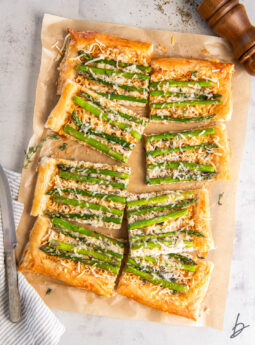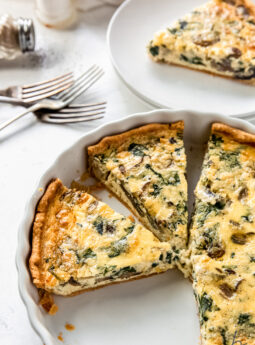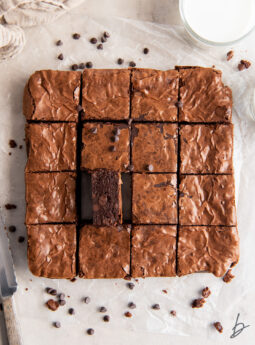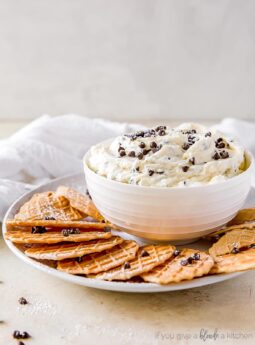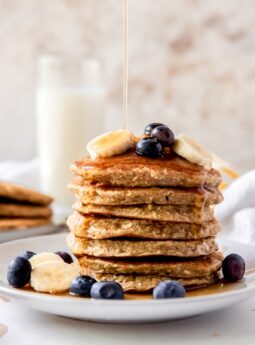Rosemary Focaccia Bread Recipe
Rosemary focaccia bread is easy to make at home. This bread is flavored with rosemary, olive oil and garlic.
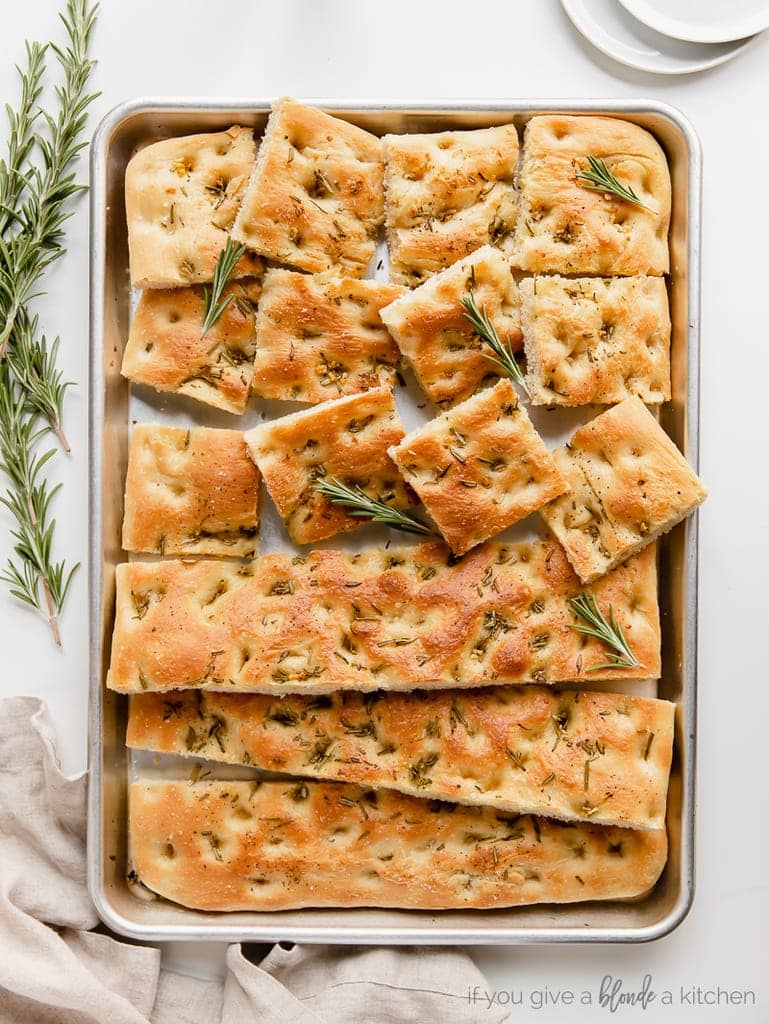
Rosemary focaccia bread is arguably my favorite savory bread. It’s an Italian flatbread that is similar to pizza dough. It’s characteristic combination of rosemary, garlic and olive oil is irresistible. Thankfully this bread is incredibly easy to make at home and pairs well with numerous dishes! You may also like savory rosemary shortbread cookies.
Why this recipe works: This recipe is versatile. You can use instant yeast or dry active yeast; all purpose flour or bread flour; rosemary plus other herbs! It also freezes well if you make a big batch.
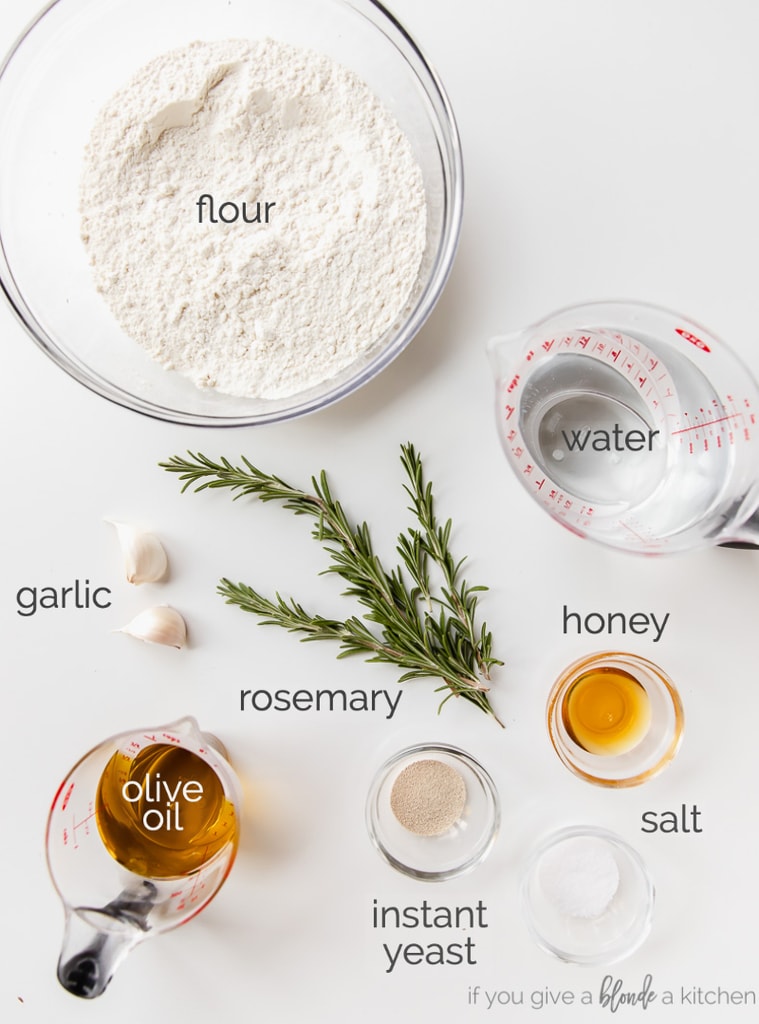
Overview: How to Make Focaccia Bread
- Make the dough: Whisk yeast and warm water together and let it sit for 5 minutes. Add remaining water, olive oil, honey, salt and 1 cup flour. Whisk together again. Add remaining flour and knead in the stand mixer for 5 to 8 minutes until dough pulls away from the sides. Transfer to a lightly oiled bowl, cover and let the dough rise 1 to 2 hours until doubled in size.
- Shape the dough: Punch the rise dough down and transfer it to a well oiled 12×17 inch baking sheet. Use your hands to gently pull the dough to the edges of the pan.
- Let the dough rest: Cover the dough tightly and let is rest in the refrigerator for at least 1 hour (up to 24 hours). Remove from the refrigerator and let the dough come to room temperature. Preheat oven to 450 F.
- Prepare the topping: Whisk together olive oil, fresh rosemary and minced garlic. Set aside. Use your fingers to poke holes in the dough. Drizzle mixture over the dough and use a pastry brush to spread it evenly.
- Bake the focaccia bread: Bake at 450° F for 20 minutes until light brown on top. Cut and serve warm or room temperature.
Wondering what size pan works best? This half sheet pan (12×17) I own works perfectly. You can also bake two smaller breads in two quarter sheet pans.
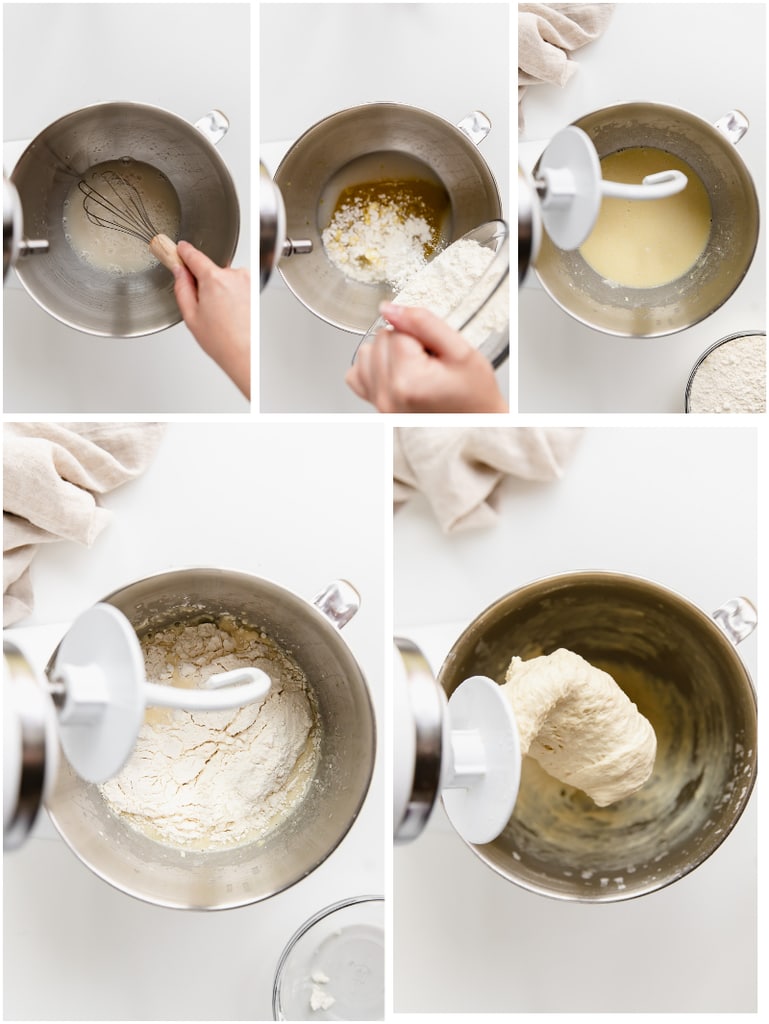
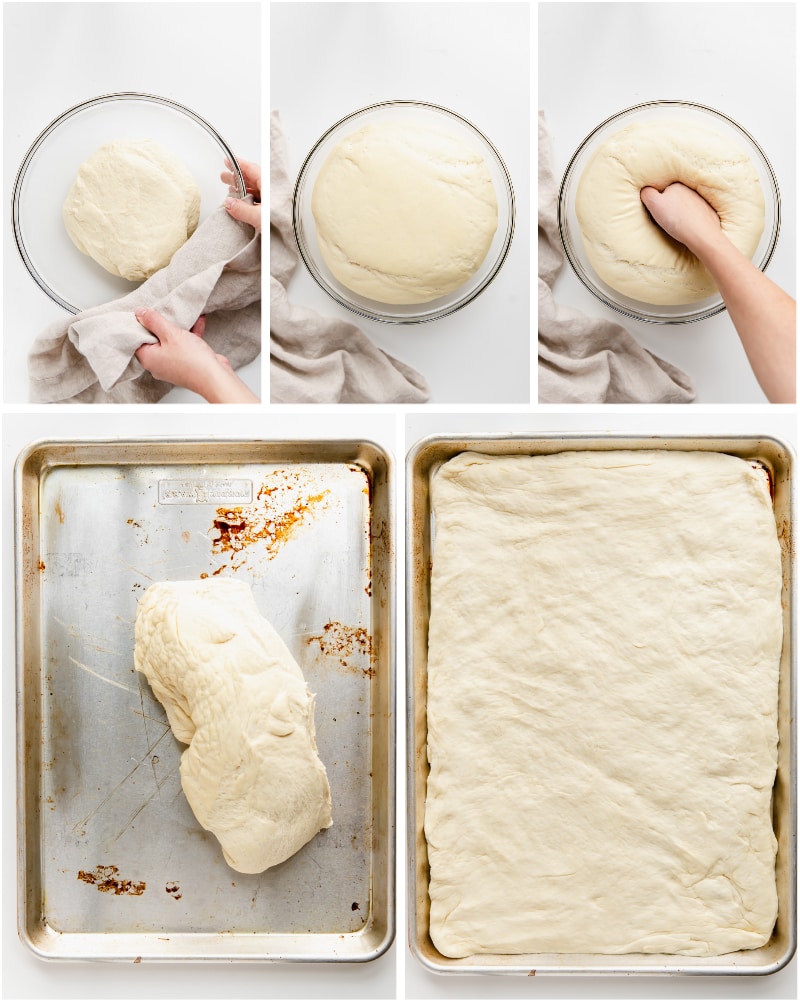
Tips for making focaccia
Aim for a soft dough that doesn’t stick to your hands. Don’t be afraid to add more flour in order to get this texture! If the dough keeps springing back when you spread it on the pan, let it rest under a clean kitchen cloth for 10 minutes, then spread the dough to the edges again. It should keep its shape better after the gluten rests.
Let the dough rest for up to 24 hours. The longer the dough rests in the refrigerator, the more flavorful it will be. I usually let mine rest 8 to 12 hours. If you want a crispy focaccia crust, turn the oven on broil for the last 1 to 2 minutes of baking (keep a close eye on it so it doesn’t burn).
Do you enjoy bread making? Try my no knead artisan bread recipe or homemade sandwich bread.
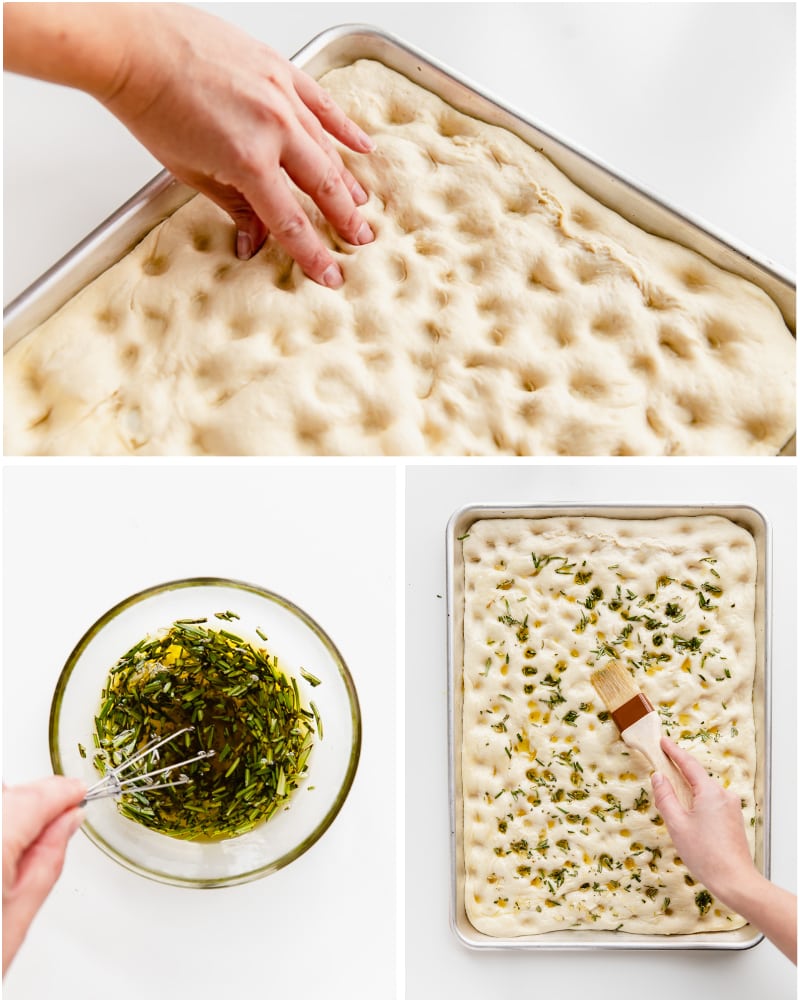
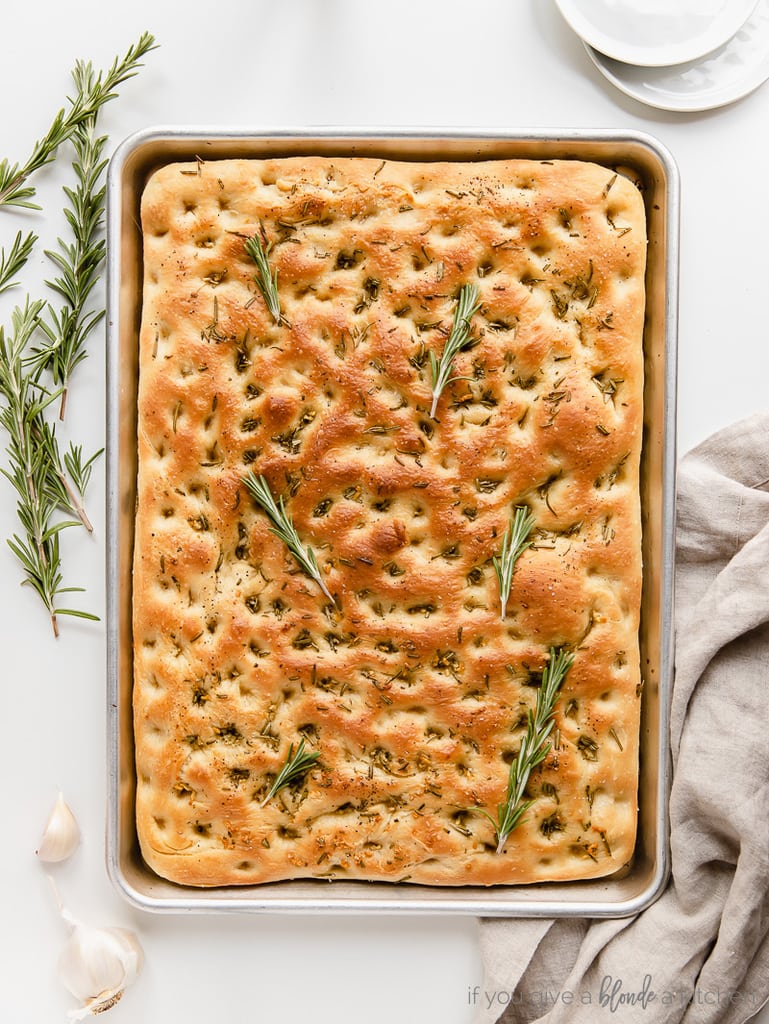
Frequently Asked Questions
Cover focaccia with aluminum foil and store at room temperature for 2 days or in the refrigerator for 1 week.
Reheat bread in a toaster oven or in a preheated 325° F oven and bake for 5 minutes.
Wrap cooled bread in aluminum foil and store in a freezer safe bag or airtight container up to 1 month. Defrost in the refrigerator before reheating in a 325° F oven for 5 minutes.
Fresh basil and thyme work well in this recipe.
Yes, however use no more than 2 tablespoons as dried herbs have strong flavor than fresh when baked.
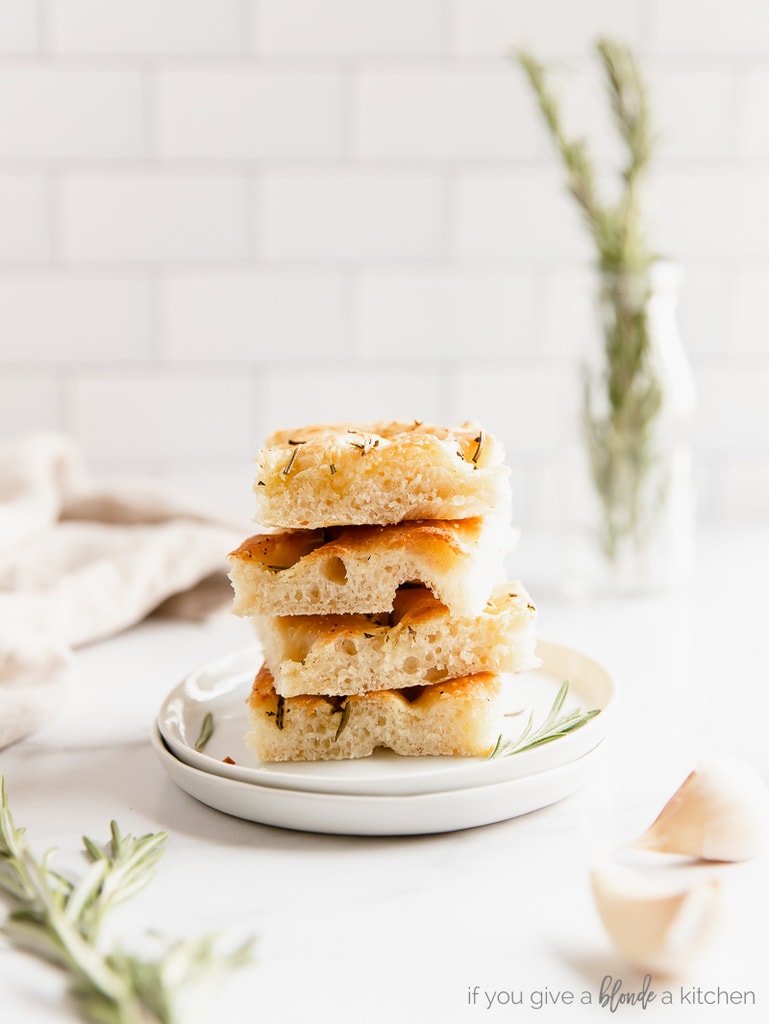
What to eat with focaccia
Rosemary focaccia bread goes well with various dishes. To state the obvious, it pairs well with pasta dishes such as this one pot baked ziti or penne alla vodka. I also like to serve focaccia with minestrone soup or harvest vegetable soup. If you’re entertaining guests, you can serve focaccia beside a Greek eggplant dip or roasted cherry tomato salad.
Do you have other dishes you like to serve with focaccia? Let me know in the comments when you try this recipe!
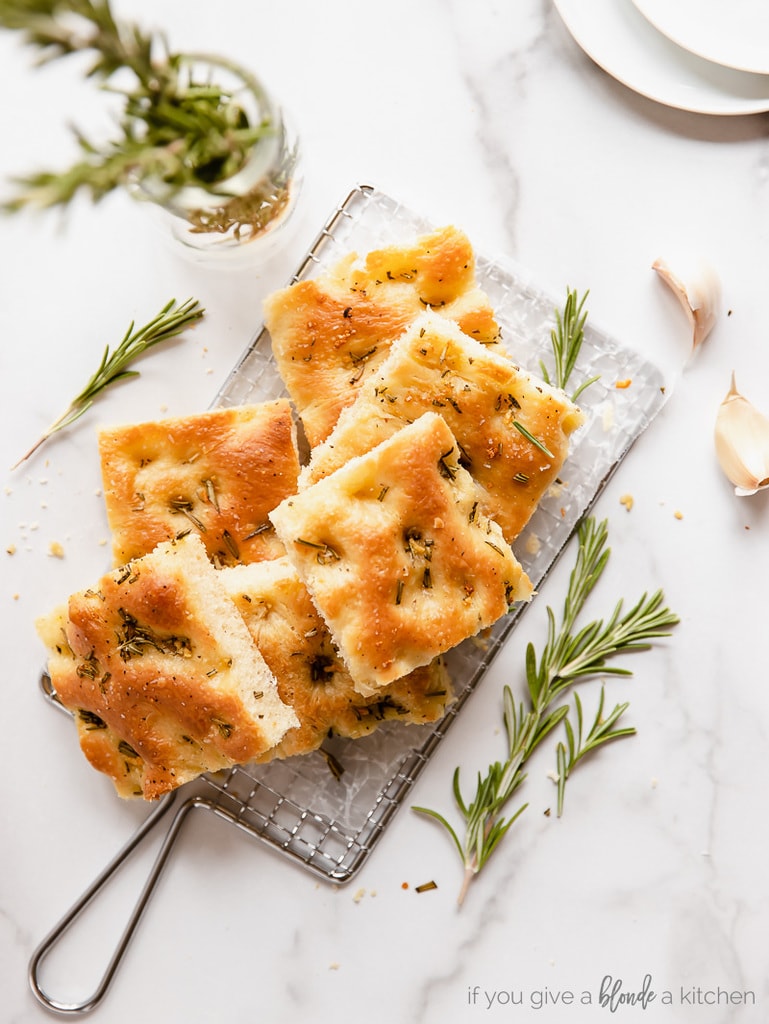
Rosemary focaccia bread is a favorite among many. It’s even better when it is homemade! Be sure to read the tips above for successful baking. If you try this recipe before to tag @ifyougiveablondeakitchen on social media so I can see your creation!
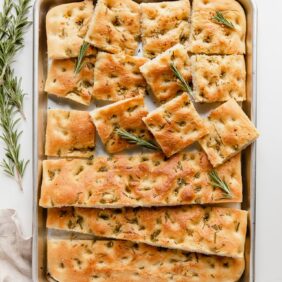
Get the Recipe: Rosemary Focaccia Bread
Ingredients
Focaccia Bread
- 1 ¾ cup (414 mL) warm water,, about 105° to 110° F
- 2 teaspoons instant yeast, (you can also use active dry yeast)
- ¼ cup (60 mL) extra virgin olive oil
- 2 teaspoons honey
- 1 ½ teaspoons salt
- 4 ½ cups to 5 cups (562 g to 625 g) all purpose flour*
Rosemary Topping
- 3 tablespoons (45 mL) extra virgin olive oil,, plus 2 tablespoons for greasing pan
- 2 garlic cloves,, minced
- 2-3 Tablespoons chopped fresh rosemary,
Instructions
- Make the dough: In the bowl of a stand mixer, whisk together 1 cup warm water and instant yeast. Let sit 5 minutes. Add remaining 3/4 cup warm water, 1/4 cup extra virgin olive oil, 2 teaspoons honey, 1 1/2 teaspoons salt and 1 cup all purpose flour. Mix together on low speed with the dough hook attached until combined, about 30 seconds. Add 3 1/2 more cups of flour and knead on low speed for 5 to 8 minutes. If the dough is sticking to the sides of the bowl, add more flour (up to 5 1/2 cups). The dough should be soft and bounced back when press gently with one of your fingers (dough should not stick to your fingers easily).
- Let the dough rise: Transfer the dough to a large, lightly oiled bowl. Cover with a clean kitchen cloth and let it rise in a warm spot (I leave mine on the counter in the summer or by a sunny winder in the winter). Let dough rise for 1 to 2 hours or until doubled (even tripled) in size.
- Shape the dough: Punch the risen dough down and set aside. Use 2 tablespoons olive oil to generously grease a 12-inch by 17-inch baking sheet with a 1 inch rim. Place dough on the baking sheet and use your hands to gently pull the dough until if fits to the edge of the pan. Do not rip the dough. If it keeps bouncing back to its original size, cover it with a clean kitchen cloth and wait 10 minutes for the gluten to settle. It should be easier to pull the dough to the edge of the pan now. Reference the video below for visual aid.
- Let the dough rest: Tightly cover the pan with aluminum foil (or plastic wrap) and place it in the refrigerator for 1 hour. You can keep it in the refrigerator for up to 24 hours. The longer it rests the better the flavor!
- When ready to bake the bread, remove the pan from the refrigerator and let it rest at room temperature while the oven preheats and you make the topping. Preheat oven to 450° F.
- Prepare the topping: In a small bowl, whisk together the 3 tablespoons extra virgin olive oil, rosemary and minced garlic. Set aside.
- Use your fingers to gently press into the dough (it may have risen a bit when it came to room temperature). Have fun with this step! You can reference the video below for visual aid. Drizzle the rosemary olive oil topping over the dimpled dough. Use a pastry brush to spread the topping around as best you can. If necessary, add more olive oil. Sprinkle with salt and pepper if desired.
- Bake the bread: Make sure the oven has been at 450° F for at least 10 minutes so it's really hot. Bake the bread for 20 to 22 minutes or until lightly brown on top. If you want a crunchy top, turn the oven on broil for the last 1 to 2 minutes (keep a close eye on the bread so it doesn't burn!)
- Let bread cool for 5 minutes in the pan before cutting and serving warm. Focaccia bread also tastes good at room temperature. °



